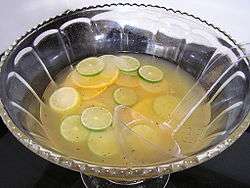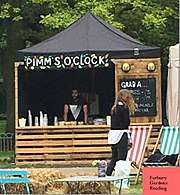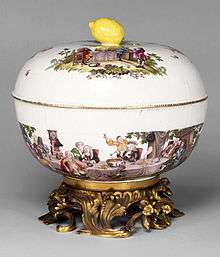Punch (drink)
The term punch refers to a wide assortment of drinks, both non-alcoholic and alcoholic, generally containing fruit or fruit juice.[1][2] The drink was introduced from India to the United Kingdom by sailors and employees of the British East India Company.[3] Punch is usually served at parties in large, wide bowls, known as punch bowls.
| Cocktail | |
|---|---|
Southern Bourbon punch | |
| Type | Mixed drink |
| Standard drinkware | Often served in a punch bowl with punch glasses. |
| Commonly used ingredients | Usually fruit juices and other drink mixers, optionally with alcohol. |
| Preparation | Varies widely. Many prepared mixes are available. |

In the U.S., federal regulations provide the word "punch" to describe commercial beverage products that do not contain fruit or fruit juice. The term is used to label artificially flavored beverages, with or without natural flavorings, which do not contain fruit juice or concentrate in significant proportions.[4] Thus a product labeled as "fruit punch" may contain no fruit ingredients at all.
History
The word punch may be a loanword from Hindi पाँच (pāñć), meaning "five", as the drink was frequently made with five ingredients: alcohol, sugar, lemon, water, and tea or spices.[5][6] Some believe the word originates from the English puncheon, which was a volumetric description for certain sized barrels used to transport alcohol on ships.[7]
The drink was brought to England from India by sailors and employees of the British East India Company in the early 17th century. From there it was introduced into other European countries. When served communally, the drink is expected to be of a lower alcohol content than a typical cocktail.[3][8]
The term punch was first recorded in British documents in 1632. At the time, most punches were of the wassail type made with a wine or brandy base. But around 1655, Jamaican rum came into use, and the "modern" punch emerged. By 1671, documents make references to punch houses.
As the need for a single-serving punch became evident, the sling, composed of spirits, water, and a sweetener,[9] was invented.[10]
Variations
Non-alcoholic
Non-alcoholic varieties, which are especially given to children as well as adults who do not drink alcohol, typically include a mix of fruit juice, water, and a sweetener such as sugar. Lemon-lime soda, ginger ale, or other fruit-flavored carbonated sodas are often added. It also often contains slices or chunks of actual fruit such as oranges and pineapple. The non-alcoholic versions are typically served at school dances, church functions, picnics, and other similar social occasions.
Commercial manufacturers distribute many types of "fruit punch" beverages. These are usually colored red. Despite the name, most brands contain only a small fraction of actual fruit juice; the major constituents are typically sugar or corn syrup, citric acid, and artificial flavors. They may also be carbonated or nonalcoholic cocktail mixers. Hawaiian Punch, Hi-C and Minute Maid are three of the better-known brands in the US. Other related drinks include Kool-Aid powdered drink mix, fassionola, and Tiki Punch (a carbonated soft drink from Shasta).
Alcoholic
Historically, most spirit based early alcoholic punches were made using either arrack or rum.[11][7][12] Bajan (Barbadian) rum punch is one of the oldest rum punches and has a simple recipe enshrined in a national rhyme: "One of Sour, Two of Sweet, Three of Strong, Four of Weak." That is: one part lime juice, two parts sweetener, three parts rum (preferably Barbados), and four parts water. It is served with a dash or two of Angostura bitters and nutmeg.
There are many rum-based punches, including Planter's Punch, Fish House Punch, Caribbean Rum Punch, and others. Arrack based punches were included in Jacob Grohusko's 1910 and Charles Mahoney's 1912 bartenders guides,[13][14] and an early recipe for arrack punch was written by Pehr Osbeck, Olof Torén, and Carl Gustaf Ekeberg in their 1771 book, A Voyage to China and the East Indies:
It is known to almost every one how punch is made; but, that it may be observed for the future where it is made to its greatest perfection, I will mention the true proportion of its constituent parts. To a quart of boiling water, half a pint of arrack is taken, to which one pound of sugar, and five or six lemons, or instead of them as many tamarinds as are necessary to give it the true acidity, are added: a nutmeg is likewise grated into it. The punch, which is made for the men in our ship was heated with red hot iron balls which were thrown into it. Those who can afford it, make punch a usual drink after dinner. While we stayed in China, we drunk it at dinner instead of wine which the company allowed the first table.[15]
Alcoholic punches are common among parties for college and university students. These punches tend to be highly alcoholic and made with cheap ingredients. They may be referred to by names such as "grain punch" (made with high-proof grain alcohol and sundry mixers) or "Jungle Juice" (liquor of various sorts brought to a BYOB party, mixed in a lined trash can with various carbonated beverages, kool-aid, or whatever is on hand). Some exclude additional water altogether and have 30% alcohol by volume (ABV) or more.
Punches around the world
Australia
Blow My Skull is a famous alcoholic punch drink that originated in mid-19th century Australia that contains rum, porter, lime, sugar, and other ingredients.
Barbados
Bajan Punch is made with rum, lime juice, cane sugar, nutmeg, and bitters. Falernum liqueur is also frequently added,[16][17] which was itself an early form of punch made by steeping cloves with rum, lime, and other ingredients.
Caribbean
Ti' Punch, literally meaning "small punch", is a rum-based punch that is especially popular in Martinique and other French speaking islands of Caribbean. The drink is traditionally made with white rhum agricole, lime, and cane syrup.

England
Cups is a style of punch, traditionally served before the departure of a hunting party in England. It is served at a variety of social events such as garden parties, cricket and tennis matches, and picnics. Cups are generally lower in alcohol content than other punches and usually use wine, cider, sloe gin, or liqueurs as the base. They often include quantities of fruit juices or soft drinks.
A well-known cup is the Pimm's Cup, using Pimm's No.1 (which contains gin) and British-style lemonade at a ratio of 1:2; a squeeze of lemon; then add orange, lemon and apple slices; a couple of cucumber wedges; and decorate with borage flowers.
Germany

Punch (Punsch in German) refers to a mixture of several fruit juices and spices, often with wine or liquor added and mostly topped with champagne or sparkling wine. Punch is popular in Germany and with many Germans who emigrated to America. Parties on New Year's Eve ("Silvester") often include a Feuerzangenbowle ("burnt punch" or, literally, "fire tongs punch"). This is a punch made of red wine and flaming overproof rum (such as Stroh), poured over a Zuckerhut (sugarloaf), a large conical sugar cube placed in the "Feuerzange".[18] It's similar to mulled wine ("Glühwein"). Another warm punch, popular with hunters or others spending time in the cold is jagertee punch.
Indian Subcontinent
Arrack based punches were historically popular in India and Sri Lanka, where it was distilled from toddy, the wine made from sap of various palm trees.[19][20][21][22]
Korea
Hwachae is a term for traditional Korean punches. Sujeonggwa is a traditional punch made from dried persimmons, cinnamon, and ginger.
Mexico

Ponche is served during the Christmas holiday season. It is served warm. Some ingredients used to make ponche are more seasonal and even exotic. Fresh tejocotes, known to the Aztecs as Texocotli (stone fruit) are required by most. Tejocotes are the fruit of the hawthorn tree and resemble crab apples; they have a sweet-sour flavor and an orange to golden yellow color. Other ingredients in ponche are prunes, pears, dry hibiscus, star anise, and sugar cane pieces.[23]
South America
In Argentina, Uruguay and Paraguay is used to drink Clericot (also called Clericó and Clericoda) which is a similar drink to Punch being a mix between wine or cider and different kind of citrus and tropical fruits such as orange, melon, mamon, apple, pineapple, diced canned peaches and/or strawberry during summer festivities such as New Year and Christmas. Is served in a pitcher. In Paraguay is served in a clay pot called kambuchi. [24] Punch is a mix between white wine and different kind of fruits, such as diced canned peaches.
Sweden
"Punch" is typically called bål in Sweden, and is commonly served in a bowl at social functions (e.g. graduation or wedding receptions). Bål as thought of broadly should not to be confused with Swedish Punsch, which is a specific type of alcoholic punch using arrack that is considered the national drink of Sweden.[25] Due to its popularity the arrack punch saw commercial bottling in 1845, and became known more broadly outside Scandinavia as the liqueur Swedish punsch.
Dragoon punch was popular in Sweden and Norway in the early 1900s, and added both stout and beer to brandy, champagne, and sherry.[26]
United States
Some claim Planter's Punch was invented at the bar of the Planters' House hotel in St. Louis, Missouri.[27] The recipe of Planter's Punch varies, containing some combination of rum, lemon juice, pineapple juice, lime juice, orange juice, grenadine, soda water, curaçao, Angostura bitters, and cayenne pepper.[28] The first known print reference to Planter's Punch was in the August 8, 1908 edition of The New York Times:

This recipe I give to thee,
Dear brother in the heat.
Take two of sour (lime let it be)
To one and a half of sweet,
Of Old Jamaica pour three strong,
And add four parts of weak.
Then mix and drink. I do no wrong —I know whereof I speak.
Southern bourbon punch is a drink closely associated with Kentucky and other Southern states. Sweet bourbon punch is made with sweet tea (a signature drink of the South), citrus flavors and bourbon whiskey.[29] Bourbon is named for Bourbon County, Kentucky, and each year during the Kentucky Derby, recipes for bourbon punch abound.
See also
.svg.png)

- List of cocktails
- List_of_cocktails_(alphabetical)
- Fruit cocktail
- Fruit cup
- Jungle juice
- Kompot
- Mojito is rum punch with added mint
- Non-alcoholic mixed drink
- Poncha is a traditional alcoholic drink from the island of Madeira
- Punsch (an arrack-based Swedish and Finnish liqueur)
- Shrub (drink)
- Ti'Punch is a rum-based mixed drink that is especially popular in French-speaking Caribbean states
References
| Wikimedia Commons has media related to Punch (drink). |
| Look up punch in Wiktionary, the free dictionary. |
- Punch at dictionary.com
- "Surprising history of punch". History.com. Retrieved 27 January 2019.
- Edwards, Graham and Sue. The Language of Drink, Alan Sutton Publishing, 1988.
- U.S. FDA. "A Food Labeling Guide" (PDF).
- Loanwords
- Punch at the Online Etymology Dictionary
- "The History of Punch". diffordsguide.com. Retrieved 27 January 2019.
- "A Vintage Cocktail That Packs A Punch", NPR, December 30, 2010, with 3 vintage recipes
- https://punchdrink.com/recipes/singapore-sling/
- http://12bottlebar.com/2010/02/the-cocktail-and-the-sling/
- "Parlour Room Punch". punchdrink.com. Retrieved 27 January 2019.
- "How well do you know the history of punch recipes?". punchdrink.com. Retrieved 6 February 2019.
- Grohusko, Jacob (1910). Jack's Manual. NY: McClunn & Co. p. 66.
- Mahoney, Charles (1912). Hoffman House Bartender's Guide. Franklin Square, NY: Richard Fox Publishing. p. 180.
- "Lost Ingredients: Arrack". Mixology. Archived from the original on 20 January 2019. Retrieved 19 January 2019.
- "bajanthings.com". Bajan rum punch. Retrieved 31 January 2019.
- "Barbados, The Rum Island". Forbes.com. Retrieved 31 January 2019.
- "Feuerzangenbowle – a Punch with a, well, Punch". gingerandbread.com/. Retrieved 30 January 2019.
- Thomas, Jerry (1862). Bartender's Guide. New York: Dic & Fitzgerald. p. 30.
- "Vintage cocktail packs a punch". www.npr.org. Retrieved 6 February 2019.
- "Artisinal Arrack". indianexpress.com. Retrieved 6 February 2019.
- "Arrack". www.diffordsguide.com/. Retrieved 6 February 2019.
- Lawson Gray, Andrea (December 16, 2014). "MEXICAN FOODWAYS: Las Posadas, contraband fruit and warm CHRISTMAS PUNCH". My Mission: Tastes of SF. Retrieved June 11, 2020 – via mymissiontastesofsf.wordpress.com.
- "Tragos de verano: Cómo preparar el clericó perfecto" (in Spanish). 2010-11-25. Retrieved 2018-10-22.
- "Punsch, A Gift from God (translated)". naringslivshistoria.se. Retrieved 26 January 2019.
- Vermier, Robert. Cocktails How to Mix Them (Second Printing ed.). Plymouth, England: Mayflower Printing. p. 79.
- Van Ravenswaay, Charles (1991). Saint Louis: An Informal History of the City and Its People, 1764-1865. Missouri History Museum. ISBN 0-252-01915-6.
- David Wondrich (2004). Esquire Drinks. Hearst Books. p. 192. ISBN 1-58816-205-2.
- Sweet Bourbon Punch Recipe Archived August 20, 2010, at the Wayback Machine
Sources
- Cross, Robert (1996). The Classic 1000 Cocktails. ISBN 0-572-02161-5.